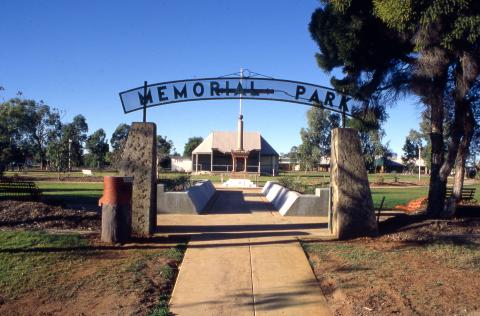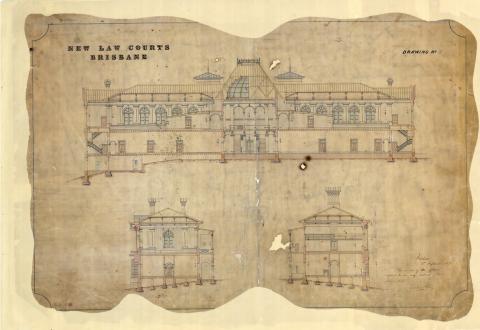- News of the day
-
Brisbane Telegraph, Saturday 21 April 1951, page 3
Big Townsville hospital opens
From A Staff Reporter with The Premier
TOWNSVILLE: Townsville's new six-storey 263-bed hospital, completed at a cost of £434,472, was officially opened by the Premier (Mr. Hanlon) this afternoon.
The Premier laid the foundation stone in 1945 when a tender of £239,987 was accepted for the work. Shortages of materials, industrial unrest and consequent dislocation of production and transport activities delayed the work.
The first move to provide increased and improved hospital accommodation at Townsville was made in 1938. Sketch plans, prepared by the architects Messrs. Donoghue, Cusick and Edwards, were approved in 1940 but the outbreak of war in the Pacific area in December 1941, with the closeness of the far northern areas to the operations of war, necessitated a postponement of the proposal.
Work was begun by the contractors, Messrs. J. Stubbs and Sons, in March, 1945. The plans then provided for a five-storey building, but during construction it was decided to add a floor.
The hospital is the largest completed as a single unit in any part of the Commonwealth since the war.
It provides accommodation for 263 beds - 163 public, 45 intermediate and 53 private.
It is claimed that in construction and facilities it has no superior for a city outside State capitals. Its modern equipment and furnishings have cost more than £35,000.
The new hospital is the first stage of a plan for many buildings to make Townsville a first-class base hospital.
Works under construction at present are a new nurses' quarters to cost £320,000 and additions and remodelling of the maternity ward (first portion) to cost £22,150.
Working drawings and specifications are nearly completed for a building to accommodate tuberculosis patients at an estimated cost of £150.000.
- Background
-
The first hospital in Townsville was opened in a cottage on the Strand in 1866 and was known as the Burdekin and Flinders Districts Hospital. In 1881 it was relocated to the present site on Stanton Hill. A two storied building was completed in 1882 and numerous buildings were subsequently built on the site.
The new Townsville General Hospital was designed by Donoghue and Fulton between 1935 and 1939 but construction was delayed due to the outbreak of war. The foundation stone was laid in 1945 by EM Hanlon and the completed building was opened by him on April 21, 1951. The new hospital was to be the largest facility of its type in Australia outside a capital city and had been built at a cost of approximately £500 000 for building and equipment. It opened with approximately 270 beds. Dr Kiernan Dorney was the medical superintendent and the hospital claimed to have the largest staff of specialists outside Brisbane.
Between 1932 and 1945 was a period of rapid development in hospitals in Queensland. This was partly due to the passing of the Hospital Act in 1923 which laid the foundations for the State Government to resume responsibility for financing and administrating public hospitals which had previously been run by voluntary committees. Under the Act the state was divided into regions and regions into districts. Each region was controlled from a base hospital which coordinated other hospitals in the region. Hospital boards, dominated by government representatives and excluding members of the medical profession, were created to oversee the administration of the hospitals. The State was to provide 60% of the running costs while the remainder was to be met by local government. The boards had the power under the act to appoint their own architects. EM Hanlon, who was minister for Health and Home Affairs from 1935 until 1944 and premier from 1946 until 1952, was responsible for many of the projects undertaken at this time. The Free Hospital Scheme was introduced to Queensland in 1946.
Tenders were called in 1947 for new nurses quarters at Townsville designed by JP Donoghue, Cusick and Edwards. By 1964 the hospital complex also included a maternity hospital, a thoracic block, isolation and psychiatric annexes, a dental clinic, an Institute of Tropical Medicine (established in 1910 and the first medical research organisation in Australia) and a Commonwealth Serum Laboratory.
Other hospital works designed by Donoghue and Fulton include general hospitals at Kingaroy (1936-38), Ayr (1941) and Roma, the Nurses' Quarters at Nambour Hospital (1937-38) and maternity hospitals at Goondiwindi, Rockhampton, Warwick and Nambour. Later works include the Barcaldine General Hospital by Fulton and Collins built in 1957 and the Thoracic Block at the Toowoomba Hospital by Donoghue, Cusick and Edwards in 1958.
Townsville General Hospital demonstrates the emergence of the Australia wide trend for a progressive image, inspired by European modernist architecture, for highrise hospital design. The high rise plan, in which various functions could be concentrated in vertically stacked spaces, replaced the earlier pavilion planning principles, in which detached buildings containing single wards were widely separated. Developments in medical theory meant that ventilation and isolation were no longer considered as important to the health of the patient. New priorities based on more efficient use of space, staff, circulation between different parts of the hospital and reduced heating costs led to the popularity of the much more compact highrise type of hospital. Block 3 at the Brisbane General Hospital, designed in 1930, was the first hospital building in Queensland to fully incorporate the principles of the highrise plan. It was designed in the Spanish Mission style to coordinate with the earlier Blocks 1 and 2. The design for Townsville General Hospital was probably the first in Queensland to combine highrise planning principles with a progressive modern image.
First introduced into Australia in the 1930s the highrise plan soon dominated new hospital construction. Melbourne architects Stephensen and Meldrum, later Stephensen and Turner, and Leighton Irwin were noted specialists in this increasingly complex field of architectural design. The development of modernist architecture in Australia is often associated with hospitals designed by these firms in the 1930s and 1940s.
Charles Fulton is recognised as a key practitioner to have designed in the modern style in Queensland before the Second World War. Fulton was born in Sydney in 1906 and undertook his architectural training there. He worked in London for B George, Architects in 1931 and 1932. In 1933 he was employed by Hall and Cook in Brisbane and he established his practice with Donoghue in 1937. Fulton received acknowledgment for his skilled execution of this style for the Masel residence at Stanthorpe through a meritorious architecture award in the first Queensland awards programme in 1938 and again in 1940 for his own residence at Indooroopilly. In 1937 Fulton was appointed Lecturer in Charge of Architecture at the Central Technical College.
Courtesy of Queensland Heritage Register
/146.8132881,-19.2516189,7/450x450@2x.png?access_token=pk.eyJ1IjoicXNhLWRpc2NvLXFsZCIsImEiOiJjamJmdTgyZXEyeWNjMnlxZm8xcmtieHgxIn0.lmT9J5tTPKGuuccQgCVSAg)



